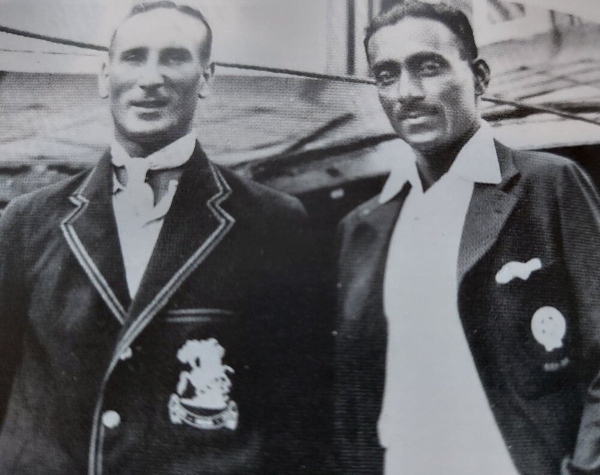Latest Contributions
The First Test Match in India

Arunabha Sengupta grew up in Calcutta and worked around the globe. A post-graduate in statistics from Indian Statistical Institute, he spent years working in New York, Chicago, Los Angeles, Zurich, and is now a Dutch citizen, settled as a writer based in Amsterdam.
He is the author of Sherlock Holmes and the Birth of the Ashes (2015, shortlisted for Cricket Society Book of the Year award), Apartheid: A Point to Cover (May, 2020) and co-author of Sachin and Azhar in Cape Town (Jan, 2021).
Government offices were closed.
A new 10,000 capacity double-decker stand was erected at the Bombay Gymkhana ground.
A cartoon in Times of India depicted a Lion and a Tiger tossing the coin, while a Kangaroo in flannels watched from afar. “And may the best side win,” said the caption.
The Gymkhana flew a Union Jack, and alongside flew the ‘rhubarb and custard’ of MCC on one side, and the Indian blue on the other. The blue, the supposed Indian flag, was the flag of the British Raj.
The Indian National Congress had adopted the saffron, green and white as India’s national flag, but of course there was no place for that.
The band played God Save the King.
The first ever Test match on Indian soil.
(We indeed have to thank the Englishmen for that. In 1888-89, Owen Dunell, a Port Elizabeth businessman hailing from Eton and Oxford, led a group of expat English buddies against a motley group of mostly average, arbitrarily chosen English cricketers. Dunell’s wife embroiders SA on each of the caps of the home cricketers. It became recognized as the first ever Test match in South Africa. A privileged mockery of history that persists to this day in record books.]
Thankfully no Englishman pulling strings in Wisden or Cricket or MCC had the brainwave to mark Vernon’s or Hawke’s Englishmen or Headlam’s Authentics playing Europeans or (English) Gentlemen of India as Test matches.
Hence, it was a team of actual Indians led by CK Nayudu who achieved the distinction. Jardine led the MCC team.

The Test was expectedly one-sided.
Verity, Nichols and Langridge restricted the India
Indian got off to a slow 219 at just over two an over. Following this Bryan Valentine hammered 136, skipper Douglas Jardine got 60 and Cyril Walters 78. England got exactly double India’s score managing a rate of over 3 an over.
The home side’s hour of glory came late, and mattered little in the context of the match. But it went down as a spectacular moment of history.
Young debutant Lala Amarnath and his veteran captain Nayudu came together on the third afternoon at 21 for 2, and batted through the day to take the score to 159. In the process Amarnath hit the first ever Test hundred for India, scored in 117 minutes, studded with 18 fours.

As Amaranth completed his hundred, two delighted spectators ran in to celebrate. Nayudu, having just completed his run, left his ground toward them . Even as he was shepherding the revellers away, the throw came in to wicketkeeper Elliott, who whipped off the bails.
Jardine, the man Australia had branded as a villain and MCC had earmarked as scapegoat, stepped in quickly. Elliott was prevented from appealing by a gesture from the skipper. Nayudu was allowed to return to his crease.
Even then skeptical English writers wondered if he would have shown the same magnanimity had it been Australians at the crease.
Amarnath had to be escorted back by the police, guarding him against the spectators who had spilled on to the ground. On arrival at the pavilion he was garlanded by the Mayor. Two Maharajahs — Kolhapur and Baroda— were among those who waited to congratulate the hero. Women supposedly tore off their ornaments to fling them at him. Local jewelers competed with each other to shower him with gifts.
“I hope his head is screwed firmly,” wrote EHD Sewell in Times of India.
The next morning, Nayudu fell for 67, Amarnath for 118 and India lost by nine wickets. A pity for all those who had arrived in Bombay on overnight trains as the news of his hundred had spread.
They did get to see a young debutant make a fighting 30 after the two were dismissed. This man had missed the inaugural tour of England in 1932 when the Hindu Gymkhana had boycotted the tour to protest the arrest of Mahatma Gandhi.
By the tour of 1936 Vijay Merchant would become the mainstay of Indian batting and would continue to be so for next 15 years.
By the way, the umpires for the series were Australian Frank Tarrant and Englishmen John Higgins and Bill Hitch.
Indian umpires were not deemed suitable to officiate in matches involving English cricketers, much like native judges presiding over Englishmen in India
The tale of the first Test in India. It began on 15 Dec 1933.
Comments
Nostalgia
Good to read these names -Jardine, Amarnath, Nayudu, Merchant ... faint memories fro young days,
Add new comment